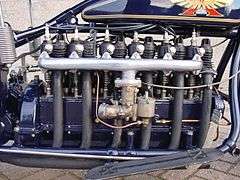Longitudinal engine
In automotive engineering, a longitudinal engine is an internal combustion engine in which the crankshaft is oriented along the long axis of the vehicle, front to back.[1][2]
.jpg)

This type of motor is usually used for rear-wheel drive cars, except for some Audi and SAAB models equipped with longitudinal engines in front wheel drive. In front-wheel drive cars a transverse engine is usually used. Trucks often have longitudinal engines with rear-wheel drive.
For motorcycles, the use of a particular type depends on the drive: in case of a chain or belt drive a transverse engine is usually used, and with shaft drives a longitudinal engine. Longitudinal engines in motorcycles do have one disadvantage: the "tipping point" of the crankshaft tilts along the entire motorcycle to a greater or lesser degree when accelerating. This is partly resolved by having other components, such as the generator and the gearbox, rotate in the opposite direction to the crankshaft.
Most larger, "premium" vehicles use this engine orientation, both front and rear wheel driven, because powerful engines such as the inline-6 and 90° big-bore V8 are usually too long to fit in a FF transverse engine bay, while most mainstream modern vehicles use front wheel drive along with a transverse engine arrangement.
Cars with longitudinal engines usually have a smaller minimum turning circle than those with transverse engines. This is because there is more space to the sides of the engine, allowing deeper wheel arches so the front wheels are able to turn through a greater angle.
Honda and Toyota were also offered cars with longitudinal engines, namely Honda Vigor, Acura/Honda Legend/RL and Toyota Tercel.
Common types of longitudinally placed engines
This is a list of typical examples of types of engines which can be placed in motor vehicles:
- in-line or straight engine — where two, three, four, five, six, and even eight cylinders are placed in a single plane.
- V engine — where two, four, six, eight, ten, twelve, or even sixteen cylinders are placed in two separate planes, looking like a "V" when viewed from the end of the crankshaft.
- flat or boxer engine — where two, four, six or more cylinders are arranged in two diametrically horizontally opposed planes.
- W engine — where two (narrow angle) vee engines are siamesed together (within 180°), where at eight, twelve or sixteen cylinders are arranged in four separate planes.
References
- Pickerill, Ken (Jun 26, 2009). "Glossary". In Main, Larry (ed.). Automotive Engine Performance. Today's Technician (5th ed.). Clifton Park, NY USA: Cengage Learning. p. 464. ISBN 978-1-43544-520-8.
Longitudinal engine mounting An engine mounted lengthways in the chassis.
- Duffy, James E.; Scharff, Robert (Mar 1, 2003) [1988]. "Chapter 2: Vehicle Construction Technology". In Clark, Sandy (ed.). Auto Body Repair Technology (4th ed.). Clifton Park, NY USA: Cengage Learning. pp. 25–26. ISBN 0-7668-6272-0.
A longitudinal engine mounts the crankshaft centerline front to rear when viewed from the top.